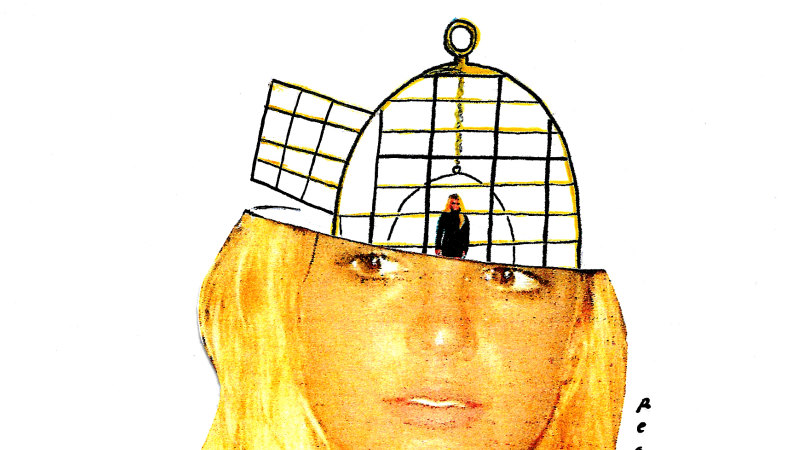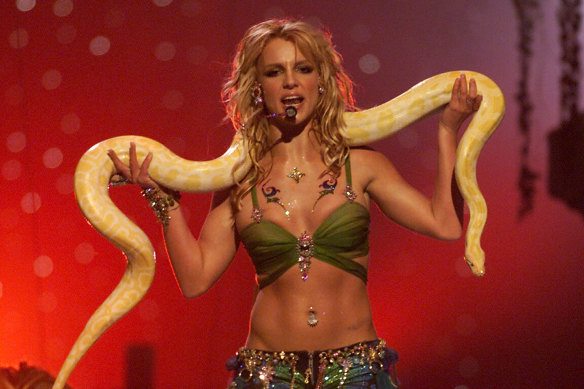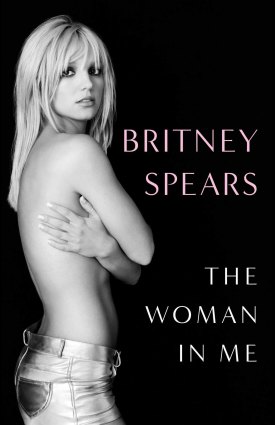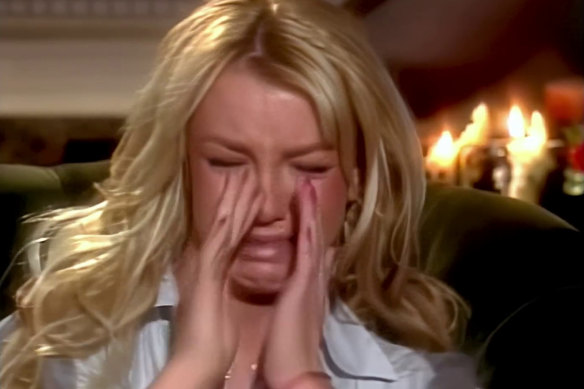Save articles for later
Add articles to your saved list and come back to them any time.
Britney Spears’ memoir needs to be heard to be believed. The audiobook of her newly released autobiography, The Woman in Me, is as compelling as they come. Spears herself reads a prologue, with her lilting Louisiana vowels, before actress Michelle Williams takes over for the main narrative. But even when Williams is on the microphone, it is Spears’ voice you hear – smart, funny, chippy and strong.
Britney Spears at the 2001 MTV Video Music Awards in New York City. She’s confronted more dangerous vipers in her time.Credit: ImageDirect/Getty
Apart from being a page-turning account of fame, downfall and rebellion from control, the story is a fascinating insight into small-town America. The people of Kentwood, Louisiana, where Spears grew up with her difficult family, are subject to the forces of Trump’s America, the ones we read about but rarely see sympathetically depicted: the ravaging effects of addiction on family, financial insecurity, accidents and illnesses which derail lives, and the control of women and girls, often through the lever of their fertility.
Spears is funny. Recalling some of the happier moments in her childhood – which was overshadowed by her father’s alcoholism, and his cruelty and control – Spears tells how she and her mother used to go on day trips to the beach at Biloxi, Mississippi, with her little sister Jamie-Lynn.
“My sisters and I had matching bathing suits and matching perms,” she recounts. “Now it’s basically illegal to give a little kid a perm, but back in the ’90s it was just cute as HELL.”
Britney Spears’ memoir reveals her as smart, funny and strong.
The road trips to the beach, when Spears was 13, were delightful mother-daughter experiences. Spears and her mother Lynne would drink alcohol together, and the alcohol made them “happier, more alive and adventurous”.
“As we’d drive, I’d sip on a little bitty White Russian,” Spears says. “To me the drink tasted like ice cream. When I had the perfect amount of shaved ice and cream and sugar and not too much alcohol, that was my piece of heaven.”
It’s an anecdote made more shocking by the lack of retroactive commentary from Spears on her mother’s parenting choices.
This is a happy memory for her: “We had a lot of fun. Even amid all the darkness there was still a lot of joy in my childhood”.
The story illustrates the corrupting influence of adults in her life, and how, even as a child, she functioned to serve her parents’ interests (as road-trip galpal, as pay cheque), rather than the other way around.
The image of the all-American teen contentedly sipping liquor as though it were a strawberry sundae seems a perfect metaphor for what Spears later became to an eager public: a girl who was marched into adulthood early and then punished for being sexualised.
Illustration: Reg Lynch.Credit:
Three years after day-drinking with her mum in Biloxi, Spears tore pop culture open with her debut single, Baby One More Time. She became famous in a way that is hard to recover from. In the accompanying music video, Spears danced through the halls of a highschool like it was a strip club, wearing a tiny Catholic schoolgirl outfit, her midriff bare and her mouth and eyes opened in sexualised faux-innocence.
Released in 1998, the video set the standard for the Lolita-fetishising noughties, where female celebrities such as Paris Hilton, Lindsay Lohan and Spears were brutalised by the paparazzi for the enormously popular supermarket magazines of the era — the ones rabidly consumed by women (including this one).
Spears’ memoir details the time when her path diverged from her male peer and then-boyfriend, Justin Timberlake. In her telling, she fell pregnant aged 19 to Timberlake, who she met as a child when they were both Mickey Mouse Club mouseketeers (a form of child stardom unique to America). She says he urged her to terminate the pregnancy (Timberlake has not commented publicly on the revelations). American healthcare being what it is, Spears had a medical abortion and writhed in pain on her bathroom floor as it happened. Instead of getting her a doctor, Timberlake got his guitar. He thought his music might soothe her.
Timberlake was young and can perhaps be forgiven for this stupidity, but is it hard to forgive how easily he discarded Spears afterwards, while painting her as the “cheating” villain of their relationship, and going on to sell an album off this narrative. His career has flourished since.
Britney Spears during her interview with Diane Sawyers in 2003.Credit: ABC
In an extraordinary 2003 interview with a 21-year-old Spears, renowned broadcaster Diane Sawyer confronts her with her crimes against Timberlake. “You did something that caused him so much pain, so much suffering. What did you do?” Sawyer asks a shamefaced Spears.
After a montage of Spears dancing in her film clips, Sawyer lip curls as she asks her: “What happened to your clothes?”
Later, Spears broke down under the public glare, shaved her head one night, in a biblical rage captured by paparazzi, and went on to attack those paparazzi with an umbrella (in hindsight one admires the restraint she showed in her choice of weapon).
In 2008, she was declared mentally ill, and placed under a state-sanctioned conservatorship controlled by her father, the same man whose alcoholism had terrified her as a child. Spears lived under that peculiar form of enslavement for 13 years, during which time she was coerced into performing a lucrative Las Vegas residency, and had her movements, diet, medication and social life controlled.
She says she wasn’t able to bathe alone and she wasn’t allowed to shut her bedroom door when she slept.
She was released from the conservatorship in 2021, following media reporting and the dogged fan-activism of the “Free Britney” movement.
Spears is now one of a slew of female public figures of the recent past, including Monica Lewinsky and Taylor Swift, whose media treatment is being reappraised as harmful and misogynistic.
Why should we care? Because ordinary girls take their cues from what happens to women in the public eye. The low-slung miniskirts and platform heels of noughties-era pop stars like Spears and Christina Aguilera live on in the startlingly adult, post-Barbie dolls my daughter plays with.
And there is something too seamless about the way Spears was passed from the control of a dominant father to the control of an exploitative pop industry and a woman-hating media and back to the control of her father, enabled by the Californian legal system, which already knew her as the mad woman the world had turned her into.
Jacqueline Maley is a regular columnist.
Most Viewed in Culture
From our partners
Source: Read Full Article




